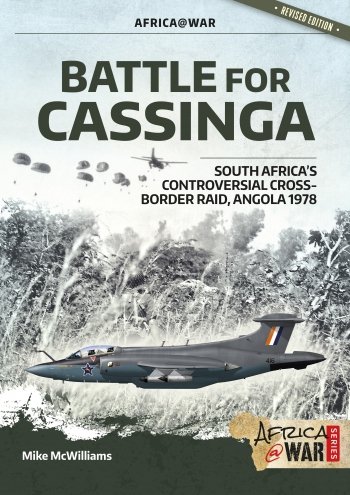-
Załączniki bezpieczeństwa
Załczniki do produktuZałączniki dotyczące bezpieczeństwa produktu zawierają informacje o opakowaniu produktu i mogą dostarczać kluczowych informacji dotyczących bezpieczeństwa konkretnego produktu
-
Informacje o producencie
Informacje o producencieInformacje dotyczące produktu obejmują adres i powiązane dane producenta produktu.HELION
-
Osoba odpowiedzialna w UE
Osoba odpowiedzialna w UEPodmiot gospodarczy z siedzibą w UE zapewniający zgodność produktu z wymaganymi przepisami.
Revised Edition This new edition features new colour aircraft and vehicle profiles from Tom Cooper and David Bocquelet.
Battle for Cassinga is the first-hand account by a South African paratrooper who was involved in the 1978 assault on the Angolan headquarters of PLAN, SWAPO’s armed wing. The battle, although a resounding success, suffered setbacks which could have proved disastrous to the South Africans had they not maintained the initiative. The improvisations made by Colonel Jan Breytenbach ensured that a flawed jump and inadequate intelligence did not adversely affect the outcome. The unforeseen Soviet-supplied SWAPO anti-aircraft guns used devastatingly in a ground role also threatened to derail the attack. A late appearance by a large Cuban/FAPLA (Angolan regulars) armoured column, from the nearby town of Techamutete, threatened to engulf the lightly armed paratrooper force still on the ground. A fierce rearguard action, together with the almost suicidal actions of the South African Air Force pilots, ultimately saved the day.
McWilliams examines why the South African government took the political risk in attacking ‘Fortress Cassinga’ in a cross-border operation that would clearly attract the ire of the world. He studies SWAPO claims that Cassinga was a refugee camp guarded by only a few PLAN soldiers, explaining why Sam Nujoma, the SWAPO leader, had no option but to perpetuate this falsehood. He looks dispassionately at all the players involved: SWAPO/PLAN and their commander Dimo Amaambo who fled the field of battle; the Cuban and FAPLA intervention; and the South African paratroopers, led by Breytenbach, who not only had to combat a determined enemy but also senior South African staff officers. Above all, it is a soldier’s tale which pays homage in equal parts to the bravery of the paratroopers and the determination of the PLAN fighters who stood to their guns until annihilated.
AFRICA@WAR SERIES
At any given time, there are at least half a dozen conflicts taking place in Africa, from civil strife and brutal insurgencies to full-blown conventional wars. Yet, apart from the grand campaigns and battles of colonial yesteryear—Omdurman, Isandlwana, Spioenkop et al—little is known outside the Dark Continent of the plethora of brushfire wars that occur with monotonous regularity. Following the Second World War, with the colonial powers—Britain in particular—looking to divest themselves of their burdensome empires, the ‘winds of change’, fuelled by the Cold War, swept through every nook and cranny of the continent. From Algeria to South Africa, from the Congo to Kenya, the continent literally erupted in conflict. Butchery and barbarism, under the guise of Black Nationalism, became bywords of African insurgencies; the tactics of terror, so espoused by Chairman Mao, one of the principal backers—in competition with Soviet imperialism—of African liberation movements, became standard operating procedure.
Africa—the continent that gave the world ‘pseudo’ counterterrorist operations as developed in Kenya to combat the Mau Mau, the Rhodesian Fireforce concept, radical innovations in vehicle mine-proofing, South African armour which fought the Cubans to a standstill at Cuito Cuanavale in the largest continental tank battle since Alamein, MiG and Mirage dogfights over the skies of Angola—is not all doom and gloom: it is as rich in its cultural diversity as it is in its martial traditions. Apart from a colourful array of liberation movements, mercenaries, brigands, pirates and terrorists, the cast includes such legendary units as the King’s African Rifles, the Portuguese Flechettes, the French Foreign Legion, the Rhodesian Selous Scouts and SAS, and the South African Recces, 32 Battalion and Koevoet.
Africa@War, a ground-breaking series, studies Africa’s post-1945 conflicts and military players in an informative and entertaining manner, examining some of the lesser known campaigns and shedding new light on some of the better known operations.








